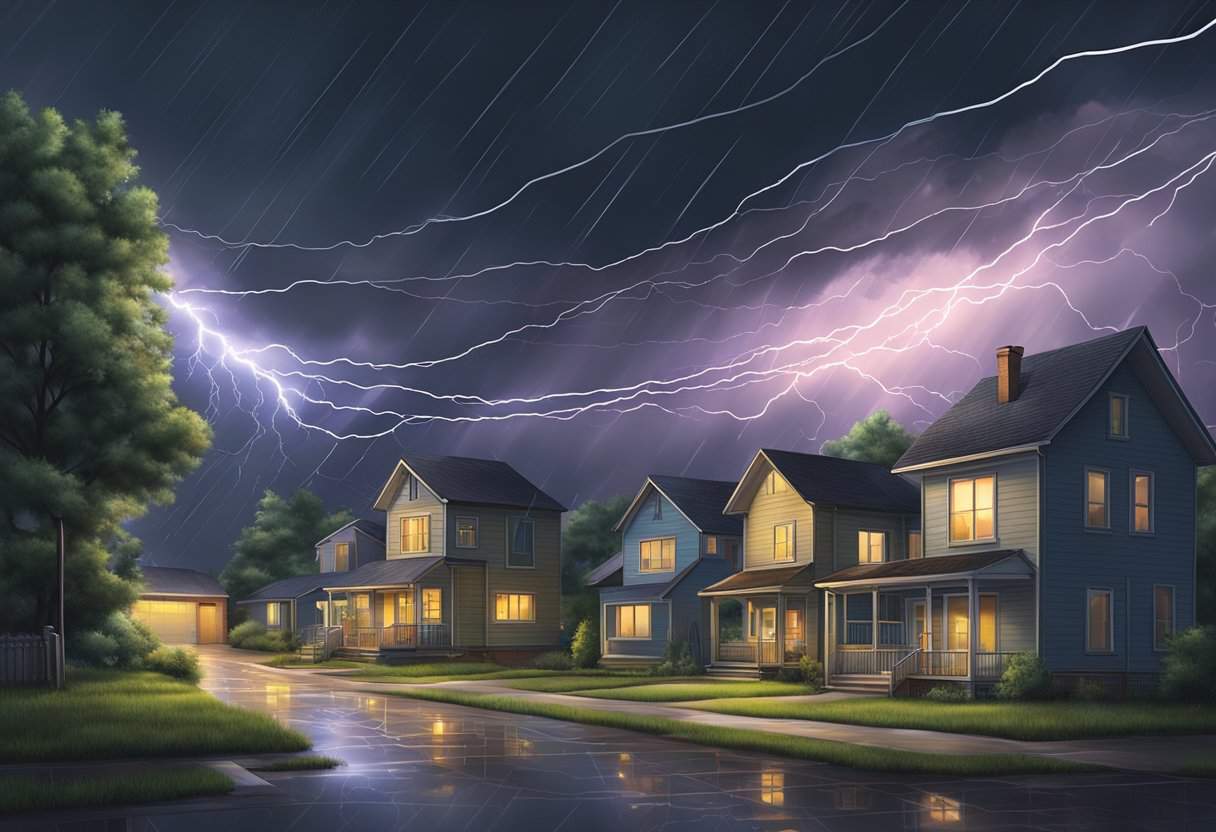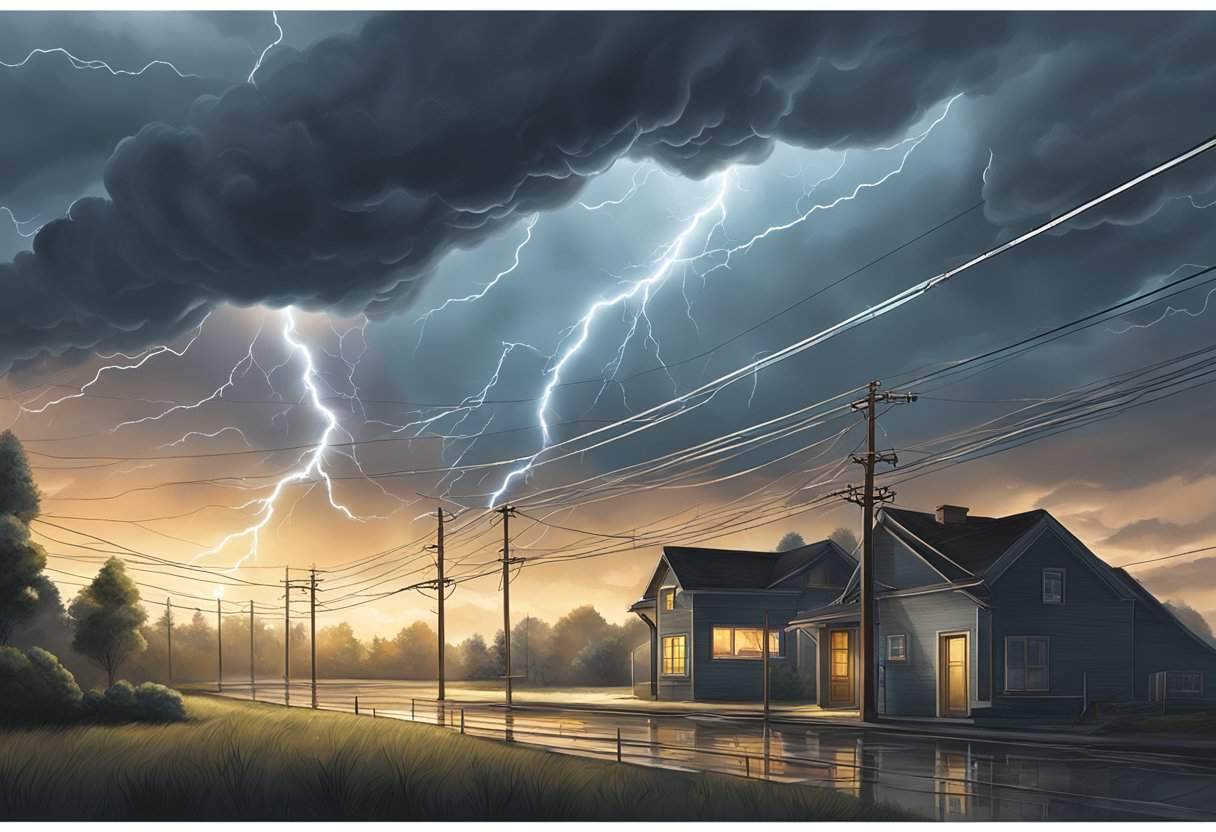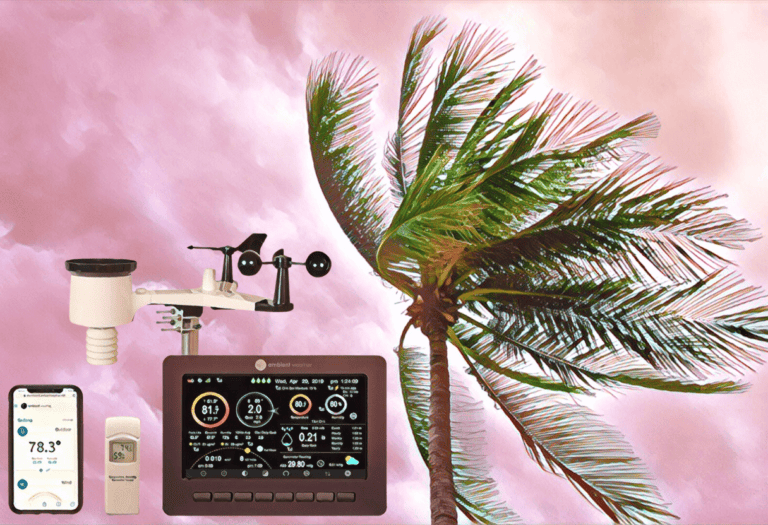Advancements in technology have dramatically changed how individuals and organizations monitor and respond to weather conditions.
Weather plays a crucial role in daily operations across various sectors, and the reliability of weather station technology during bad weather is paramount. Traditionally, wired weather stations have been the go-to choice for their dependability and direct connections. However, wireless technology is rapidly catching up, offering flexibility and ease of installation previously unattainable.
Despite the advancements in wireless technology, bad weather presents unique challenges for maintaining a reliable connection. Severe conditions such as storms and heavy precipitation can lead to intermittent signals and data loss, problems that are less common in wired systems. Understanding how these systems perform under the stress of adverse weather conditions is key to choosing the right setup for your needs.
It involves considering various factors from installation and maintenance to connectivity and data transmission, all while balancing the environmental and operational factors specific to your location.
Wired stations offer reliable data but require complex setup, while wireless stations are flexible but prone to weather disruptions. Choose based on your need for accuracy, weather conditions, and budget. Remember, backup power and weather alerts are key for both!
Understanding Weather Station Technology
Selecting the right weather station is crucial, especially in regions where accurate weather data is essential for safety and planning. Your choice between wired and wireless systems impacts not only installation but also the reliability of data during adverse weather conditions.
Defining Wired and Wireless Weather Stations
Wired weather stations are integrated systems where sensors are physically connected to a central data logger using cables. This setup ensures a continuous and stable power supply and data transmission, which can be particularly reliable during severe weather. However, the installation process can be labor-intensive, and the cables could be vulnerable to lightning strikes or wear and tear over time.
In contrast, wireless weather stations transmit data using radio frequency (RF) signals, eliminating the need for physical cables. This flexibility allows for easier installation and the ability to place sensors optimally without cable length restrictions. Despite potential issues with signal interference or battery dependency, modern advances have made wireless systems much more reliable, as evidenced by studies such as the one on Low-cost automatic weather stations within the Internet of Things framework.
Components of Weather Stations
Both wired and wireless weather stations consist of several key components, which include but are not limited to:
- Sensors: Devices that measure various atmospheric parameters. Common sensors include thermometers for temperature, anemometers for wind speed, and hygrometers for humidity.
- Data Logger: The unit that collects data from the sensors. It records and sometimes processes the data before it’s transmitted or retrieved.
- Display/Console: This interface displays the data collected by the weather station. For wireless systems, this could be a standalone monitor or an app on your smart device.
- Power Supply: Wired systems often connect to a mains supply, while wireless stations typically use batteries or solar panels.
When choosing a weather station, consider the maintenance and long-term viability of the system. Wired stations may require less frequent maintenance due to their stable power source, but laying or replacing cables can be more complex. Conversely, wireless stations may need regular battery changes, yet they offer lower installation complexity, highlighted by the development of a low-cost ZigBee-based automatic wireless weather station that emphasizes ease of use and functionality.
Assessing Weather-related Challenges
When you’re determining the right connectivity for adverse weather conditions, it’s crucial to understand how different elements affect wired and wireless systems. Let’s look at the specific challenges posed by temperature, humidity, wind, rain, lightning, and electrical interferences.
Impact of Temperature and Humidity
Temperature and humidity can significantly impact the performance of your network. High temperatures can degrade the insulating properties of wired connections, while excessive humidity may lead to condensation and corrosion. It’s important to ensure that cables are rated for the temperatures they may encounter and that wireless equipment is adequately protected against moisture.
Effects of Wind and Rain
Wind and rain bring about physical and signal disturbances. For wired networks, strong winds can damage overhead lines. On the other hand, wireless signals can be attenuated by heavy rain, a phenomenon known as rain fade. Careful planning of network topology and the use of weather-resistant materials can mitigate these effects.
Dealing with Lightning and Electrical Interferences
Lightning strikes pose a serious threat to all network infrastructures, with the potential to cause severe damage. A direct strike can destroy hardware, while indirect strikes may induce electrical interferences in your system. Implementing surge protection devices and grounding all equipment properly are critical steps in protecting against these incidents.
Comparing Wired and Wireless Systems

In exploring the robustness of wired versus wireless systems, especially in adverse weather conditions, you’ll want to consider their reliability, how weather impacts signal transmission, and the continuity of their power sources.
Reliability and Performance in Bad Weather
Wired networks, such as gigabit Ethernet (GbE), typically provide a stable connection that is less likely to be affected by bad weather. For instance, fiber-optic cables are inherently immune to weather-related interference. On the other hand, wireless communications can experience signal degradation during inclement conditions. According to a study on wireless communication networks, wireless signals, including those used for internet and mobile telephony, can be significantly impacted by conditions such as heavy rain or dense fog, leading to a reduction in the data quality and an increase in ping times.
Signal Interruptions and Transmission
The integrity of signals in a wireless setup can be vulnerable to interruption by severe weather events, while wired systems maintain a consistent signal flow protected by their physical infrastructure. FireWxNet, a portable wireless system for monitoring weather conditions in wildland fire environments, demonstrated enhanced range with a 900Mhz spectrum. However, it’s important to note that wireless networks may require additional measures, such as protective enclosures, to ensure similar reliability.
Power Source Considerations
The stability of your network’s power source is critical in bad weather. Wired networks are often powered by the electrical grid, which may be susceptible to outages during storms or other severe weather events. Battery backups can provide temporary relief, but are not a long-term solution. Wireless systems sometimes possess an advantage here, as they may be designed with integrated battery systems or renewable power sources like solar panels, allowing them to function autonomously for extended periods, as long as the battery health is maintained and the renewable sources are not impeded by the weather conditions.
Installation and Maintenance of Weather Stations
When setting up a weather station, your primary goals are to achieve reliable data accuracy and maintain system longevity. The right installation and subsequent maintenance are pivotal in reaching these goals.
Mounting and Location Factors
When mounting your weather station, you should take into account the specific environmental conditions it’s designed for. For wired stations, secure installation is especially critical in adverse weather, as the complexity of installation increases with the need for robust cabling. Ensure the site has minimal obstructions for accurate measurements and is accessible for maintenance. In contrast, wireless stations offer more flexibility in remote or difficult terrains, but they still require a clear line of sight to the sky and should be mounted away from reflective surfaces to prevent data distortion.
Weather Station Maintenance Needs
Maintenance is the linchpin of operational integrity for both wired and wireless systems. For wired systems, the integrity of cables and junctions should be regularly inspected, especially after severe weather events. Wireless systems, while less demanding in terms of physical infrastructure, require periodic checks on battery levels and sensor calibration. No matter the type, routine cleaning of sensors and protective shields ensures the longevity and accuracy of your station. It is also advisable to have a schedule in place to monitor system firmware and software updates for a fully functional setup.
Evaluating Connectivity and Data Transmission
When exploring your options for maintaining internet connectivity in inclement weather, understanding the nuances between wired and wireless systems is vital. This evaluation is particularly crucial for sustaining consistent data transmission to and from remote sensors and devices.
Pros and Cons of Internet Connection Types
Wired Internet Connection:
- Pros:
- Less susceptible to weather disruptions compared to wireless signals.
- Can provide stable data transmission through physical cables like fiber optic or coaxial cables.
- Cons:
- Fixed infrastructure could suffer physical damage due to severe weather conditions like strong winds or ice.
- Installation and repairs can be costly if access to cables is complicated by natural obstacles or mann-made structures.
Wireless Internet Connection:
Pros:
- Offers flexibility in placement of devices without the need for cable runs.
- Easier to expand coverage with additional routers or range extenders.
Cons:
- More prone to interference from bad weather, such as heavy rain or dense fog affecting Wi-Fi signals.
- Routers and other equipment might require specialized housing to protect against extreme weather conditions.
Communicating with Remote Sensors and Devices
Implementing robust communication systems with remote sensors in adverse weather conditions demands careful consideration of your internet connection’s reliability.
- Wireless Sensor Networks: These are ideal for monitoring areas that experience landslides or floods due to their adaptability, but they need to have protocols in place to maintain connectivity during rough weather. For instance, systems using wireless broadband like WiMAX have shown promise.
- Wired Sensor Networks: Although requiring a more considerable initial setup, wired networks might provide more consistent data transmission during adverse weather, avoiding the dropout issues that can affect wireless networks as outlined in a study about residential links.
Regardless of the type chosen, your network should preferably have redundancy measures and be capable of reconfiguration to reduce outages, as noted in strategies for mitigating weather-based disruptions. This can ensure that your satellite, Wi-Fi, or cable connections remain effective in supporting your remote devices and sensors, despite environmental challenges.
Considering Environmental and Operational Factors
When deploying communication networks, you must account for environmental pressures and tailor systems to meet the specific operational requirements of the area. The choice between wired and wireless options can hinge on the unique challenges presented by extreme weather conditions and the specific needs of a location.
Effects of Extreme Weather on Station Operation
Extreme Heat: High temperatures can significantly impair the performance of wired infrastructures by affecting cable integrity. Similarly, wireless sensor networks can experience reduced signal range and increased power consumption, as the Sensorscope experience has demonstrated.
Snow and Ice: Accumulation of snow can lead to physical damage to both wires and wireless infrastructure, with ice causing potential breakage and signal obstruction, leading to inconsistent network reliability.
Flooding: Elevated moisture levels from flooding can cause serious disruptions in wired networks by damaging the physical cables. Wireless networks, while less susceptible, still face challenges as water can absorb radio signals, resulting in decreased communication range.
Optimizing for Specific Needs and Locations
-
Environmental Monitoring: For monitoring in environmentally sensitive areas, wireless networks provide an unobtrusive means of data collection, as shown by projects that focus on environmental wireless sensor networks.
-
Specific Location Needs: Consider the purpose of your network. If you’re in an area prone to extreme weather, ensure that any wired components are rated for exposure to elements, while wireless nodes should have a power strategy for extended operation in case of power outages.
By carefully analyzing the risks and requirements associated with your environment and operational needs, you can choose the most resilient and efficient infrastructure for maintaining connectivity in the face weather-induced disruptions.
Cost-Benefit Analysis for Consumers
When considering the impact of adverse weather on wired versus wireless systems, you need to dissect the financial aspects of initial outlays versus long-term benefits, along with the total cost implications of owning and maintaining such systems.
Initial Investment and Long-Term Savings
Your initial investment in a wired network typically includes cabling, labor costs for installation, and additional expenses such as weatherproofing and surge protection devices to withstand extreme weather events. A wireless system, on the other hand, may save on these installation costs but could demand a higher outlay for technology like advanced routers and signal boosters.
- Wired Network Initial Costs:
- Cabling: $X per foot
- Installation: $Y
- Weatherproofing: $Z
- Wireless Network Initial Costs:
- Equipment: $A
- Installation: $B
For long-term savings, consider the maintenance and charging costs associated with smart devices within wireless networks. Conversely, solar panels can offer offsets against the power demands of wired systems, converting a portion of your energy costs into savings.
Long-Term Wired Savings:
- Decreased power outages: Reduce losses
- Solar panel integration: Save $D annually
Long-Term Wireless Savings:
- Lower maintenance: Save $C over 5 years
- Energy-efficient devices: Further cut costs by $E annually
Calculating the Total Cost of Ownership
The Total Cost of Ownership (TCO) encapsulates not just the upfront costs but also the ongoing expenses of operation and maintenance. For wired systems, material durability during severe weather events is crucial in minimizing TCO, while wireless systems require careful analysis of long-term tech upgrades and AMI upkeep.
- Wired TCO:
- Initial Investment: $XYZ
- Maintenance: $H annually
- Potential savings with solar panels: -$D annually
- Wireless TCO:
- Initial Investment: $AB
- Maintenance: $G annually
- Upgrades: $F every Z years
Remember to factor in the less tangible aspects, such as convenience during outages and the value of uninterrupted connectivity, which can influence your perception of costs and benefits. Additionally, grants or subsidies for weather-resistant infrastructure could affect your TCO calculations.
Advantages and Drawbacks of System Types
When considering the impact of weather on communication systems, it’s essential to weigh the advantages and drawbacks of both wired and wireless technologies. Understanding how each system performs under adverse weather conditions will aid you in making an informed decision based on your specific needs for accuracy and convenience.
Weather Station Accuracy and Forecasting
Wired Systems:
- Pros: Wired networks typically offer a more reliable connection which can directly translate to more accurate weather station data transmission. Their physical connections are less susceptible to atmospheric interference.
- Cons: However, wired systems can experience disruptions due to physical damage from extreme weather events such as ice storms or heavy snowfall.
Wireless Systems:
- Pros: There is a significant flexibility with wireless systems since they can be deployed without the need for extensive infrastructure. This makes them suitable for real-time monitoring in remote and changing environments, which can enhance forecasting.
- Cons: On the downside, wireless signals can be affected by bad weather, potentially reducing accuracy. Microwave signals can be particularly vulnerable to atmospheric conditions.
Flexibility and Convenience in Usage
Wired Systems:
- Pros: The setup of a wired network can result in a highly stable and secure environment, often seen as a baseline for reliable connections.
- Cons: The drawbacks include limited flexibility and higher initial setup costs. Repairs and upgrades can also be more complicated and disruptive.
Wireless Systems:
- Pros: The main advantage of wireless systems is their convenience. They allow for easy expansion, mobility, and deployment, which wired systems can’t match. The ability to quickly adapt to new conditions presents a significant benefit, especially in varied terrains.
- Cons: Wireless systems may become less reliable during bad weather, affecting both signal strength and connection reliability. This can be a critical consideration in harsh weather conditions. Wireless technologies may require robust backup systems to ensure continuous operation.
Preparing for Weather Station Outages
Dynamic weather can impact the operations of weather stations, making it crucial for you to have resilient solutions in place to minimize disruption. Ensuring the continuity of data and services during adverse weather conditions is paramount.
Backup Solutions and Power Outages
Battery backups: Having uninterruptible power supplies (UPS) or generator systems is essential in maintaining functionality during a power outage. A robust UPS can provide short-term power to critical components, allowing for continued data transmission and receipt of weather alerts. For extended outages, consider installing a generator capable of powering the entire station for prolonged periods.
Redundant systems: Deploy secondary, failover systems that automatically take over during a primary system failure. This could include additional weather monitoring instruments that are battery-powered, ensuring consistent data collection.
Weather Alert Systems and Preparedness
Real-time alerting: Integrate your weather station with a weather alert system that offers instant notifications during sudden, severe conditions. This allows you to take immediate action to protect both your equipment and data integrity.
Enhanced readiness plans: Your station should be equipped with a documented preparedness plan that outlines specific steps to take when various weather conditions are forecasted. Include protocol for frequent testing and maintain a kit with necessary tools and protective gear tailored to your geographic and climatic needs.
By proactively instituting these strategies, your weather monitoring capabilities will be far more resilient to environmental disruptions.
Conclusion
In assessing the resilience of communication systems to adverse weather conditions, it’s evident that both wired and wireless networks have vulnerabilities but also possess distinct advantages. Your choice of technology should align with your requirements for reliability and performance during diverse weather scenarios.
Choosing the Best Weather Station for Your Needs
When selecting the optimal weather station, consider the critical factors such as signal strength, which can be impacted by temperature and humidity fluctuations. Moreover, recognize that certain wireless technologies may offer faster speeds but could also be more susceptible to severe weather conditions. It’s crucial to understand that no system offers complete immunity against the forces of nature, and hence your decision should involve weighing the pros and cons of both setups in the context of meteorological events.
Frequently Asked Questions
In this section, we address common concerns regarding how various weather conditions may affect different types of internet connections, with a focus on both wireless and wired networks.
How does inclement weather impact wireless internet stability?
Inclement weather, such as heavy rain or snow, can degrade wireless network performance, leading to potential signal loss or intermittent connectivity due to signal attenuation.
What effect does extreme cold have on internet connectivity?
Extreme cold can stiffen cables and cause brittleness in the infrastructure, affecting both wired and wireless connections by making the materials more susceptible to damage—though fiber optics are typically more resistant to cold temperatures.
Can severe weather conditions disrupt fiber optic internet service?
While fiber optic cables are generally resilient, severe weather conditions such as flooding or hurricanes can physically damage cables or infrastructure, potentially disrupting the service.
Why might internet service be interrupted during stormy weather?
Stormy weather can interrupt internet service by damaging the physical network infrastructure, such as antennas or relay towers crucial for wireless connections, or by causing power outages that affect network operations.
Is wired internet connectivity less susceptible to weather fluctuations?
Wired connections, including fiber optics and Ethernet, tend to be less susceptible to weather fluctuations than wireless ones because the network components are usually shielded and buried, offering more protection from the elements.
Will strong winds interfere with my home’s internet reliability?
Strong winds are capable of damaging exposed wires or dislodging the infrastructure needed for your internet connection. This can reduce the reliability of your home’s internet, especially if you rely on a wireless service that depends on above-ground infrastructure.







